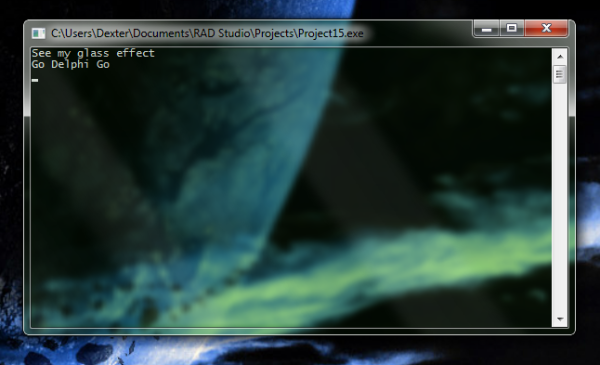我可以在我的控制台应用程序中激活玻璃效果。我使用的是Windows 7和Delphi 2010。
我发现this应用程序,所以这应该是可能的。
我发现this应用程序,所以这应该是可能的。
几周前,我在我的博客上发布了这篇文章。
关键是要使用GetConsoleWindow和DwmEnableBlurBehindWindow函数。
GetConsoleWindow函数检索与调用进程相关联的控制台使用的窗口句柄。
DwmEnableBlurBehindWindow函数启用提供的窗口句柄的模糊效果(玻璃效果)。
program ConsoleGlassDelphi;
{$APPTYPE CONSOLE}
uses
Windows,
SysUtils;
type
DWM_BLURBEHIND = record
dwFlags : DWORD;
fEnable : BOOL;
hRgnBlur : HRGN;
fTransitionOnMaximized : BOOL;
end;
function DwmEnableBlurBehindWindow(hWnd : HWND; const pBlurBehind : DWM_BLURBEHIND) : HRESULT; stdcall; external 'dwmapi.dll' name 'DwmEnableBlurBehindWindow';//function to enable the glass effect
function GetConsoleWindow: HWND; stdcall; external kernel32 name 'GetConsoleWindow'; //get the handle of the console window
function DWM_EnableBlurBehind(hwnd : HWND; AEnable: Boolean; hRgnBlur : HRGN = 0; ATransitionOnMaximized: Boolean = False; AFlags: Cardinal = 1): HRESULT;
var
pBlurBehind : DWM_BLURBEHIND;
begin
pBlurBehind.dwFlags:=AFlags;
pBlurBehind.fEnable:=AEnable;
pBlurBehind.hRgnBlur:=hRgnBlur;
pBlurBehind.fTransitionOnMaximized:=ATransitionOnMaximized;
Result:=DwmEnableBlurBehindWindow(hwnd, pBlurBehind);
end;
begin
try
DWM_EnableBlurBehind(GetConsoleWindow(), True);
Writeln('See my glass effect');
Writeln('Go Delphi Go');
Readln;
except
on E:Exception do
Writeln(E.Classname, ': ', E.Message);
end;
end.
这只是一个基本的示例;您必须检查Windows操作系统版本以避免问题。
